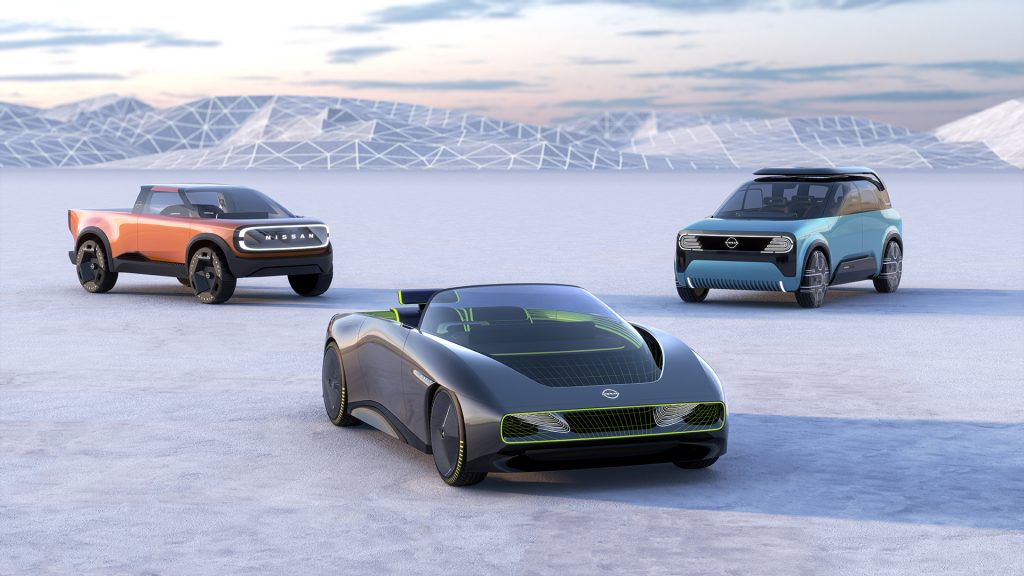Nissan has released Nissan Ambition 2030, a vision and roadmap that explores what the future of its mobility offerings will look like.
The Japanese automaker’s ultimate goal is to be carbon neutral across the life cycle of its products by 2050.
To achieve this, Nissan says it will invest 2 trillion yen (£13 billion) over the next five years, and introduce 23 new electric models, 15 of which will be available by 2030. This will give the company a global electrification mix of more than 50% across the Nissan and INFINITI brands.
When breaking this down by region, Nissan will increase its electrification mix across its major markets by 2026, so that 75% of Nissan’s sales will be electric in Europe, 55% of its sales will be electric in Japan, and 40% of sales will be electric in China. In the US, the company wants 40% of its sales to be electric by 2030.
Nissan’s chief executive Makoto Uchida said: “With Nissan Ambition 2030, we will drive the new age of electrification, advance technologies to reduce carbon footprint and pursue new business opportunities. We want to transform Nissan to become a sustainable company that is truly needed by customers and society.”
As part of Nissan Ambition 2030, the company showed off four new electric concept cars to showcase what is on the horizon.
Next-generation Crossover EV Concept: Nissan Chill-Out
Nissan has provided scarce details of this concept, but the crossover uses the CMF-EV platform and features a modern design, improved safety technology and delivers high levels of comfort inside.
Looking beyond the next-generation crossover EV, Nissan considers the future direction of EVs and how advances in batteries, technology and packaging can provide customers with a range of mobility options to suit their lifestyles. These mobility concept options are called Max-Out, Surf-Out and Hang-Out.
At the core of these three new concept cars is the skateboard-like structure that houses all solid-state battery technology (ASSB). The new fully integrated body, chassis and battery will be ultra-lightweight, it will have front and rear motors, a low centre of gravity and will be built around AI to allow agile vehicle control. The first of Nissan’s EVs to run on ASSB technology will be launched by 2028.
Nissan Max-Out concept
This is a two-seater convertible concept that Nissan says “aims to deliver a new driving experience with its superlative stability and comfort.”
Nissan Surf-Out concept
The Surf-Out concept is an off-road performance vehicle that can run on any terrain, enabling customers to travel wherever they want. It also has plenty of flat cargo space so is suitable for a range of activities.
Nissan Hang-Out concept
Described by Nissan as providing “a new way of spending time on the move”, the Hang-Out concept aims to challenge conventional notions about interior layouts. Step inside the vehicle and its spaciousness and quietness “offers the comfort of your living room in a mobile space”, according to Nissan. The floor lies completely flat and runs from the front to the back while also featuring theatre-like seats for movie nights on-the-go.
Nissan’s ambition is to make these future EV’s increasingly accessible. It will aim to reduce the cost of battery packs down to $75 per kWh by 2028. Nissan will also look to develop its lithium-ion battery technologies and introduce cobalt-free technology to bring down the cost by 65% by 2028.
To ensure its EVs are competitively priced, Nissan will localise manufacturing and sourcing.
The company’s integrated manufacturing and service ecosystem known as EV36Zero is a concept that will expand into several other core markets, including Japan, China and the US.
Catering for all these changes will require more staff and so Nissan says it will hire more than 3,000 employees, while also continuing to upskill its current workforce.
Ashwani Gupta, Nissan’s chief operating officer, said: “We are proud of our long track record of innovation, and of our role in delivering the EV revolution. With our new ambition, we continue to take the lead in accelerating the natural shift to EVs by creating customer pull through an attractive proposition by driving excitement, enabling adoption and creating a cleaner world.”
